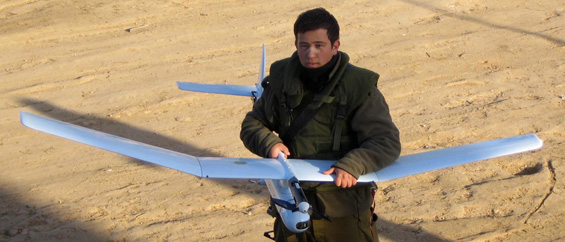January 2: Unmanned and unlawful
When three boys went outside to play marbles they became victims of an Israeli drone.

 |
| 514 people were killed by unmanned drones, during Israel’s war on Gaza [GALLO/GETTY] |
For each day of Israel’s war on Gaza, the Al Mezan Center for Human Rights reports on how one family is coping with the war’s aftermath.
In its seventh report from the Gaza Strip, Al Mezan talks to a family who lost three boys.
On January 2, 2009, 11-year-old Mohammed al-Astal, his eight-year-old brother Abed-Rabbo, and their second cousin, 11-year-old Abed-Sattar, went out to play marbles and to collect sugar cane in a sandy road near their home in Al-Qarara village in the south of the Gaza Strip.
As they played, they were targeted by an Israeli drone – an unmanned aircraft.
Drones have an array of sensors which can provide a clear image in real time of individuals on the ground. They have the ability to distinguish between children and adults and drone strikes are very precise.
A year after the attack, Al Mezan spoke to the children’s parents.
Disfigured
| 23 DAYS, 23 STORIES | |||||||||||||
|
Iyad, the father of Mohammed and Abed-Rabbo, saw the drone just minutes before the attack.
“It was just before the Asir [afternoon] prayer and my wife was making tea on the fire as there was no gas or electricity during the offensive. I noticed a drone in the sky. It was unusually low.
“I went to wash for the prayer and then I heard people shouting, ‘There’s a missile! There’s a missile!’ I heard an explosion. The last thing I expected was that it would be the children.
“My brother, Ibrahim, came by and whispered to me, ‘your father-in-law and brother-in-law have been killed.’ I didn’t know what to tell my wife. She became worried so I went outside to see what had happened.
“I walked for around 20 metres and I saw my brother, Ibrahim, again coming toward me. He said, ‘It was your two sons who were killed.’ I went to the site of the attack, but the bodies had been taken to Nasser Hospital. When I got there they were already in the morgue.”
Abed-Sattar’s father, Waleed, is a farmer and was out in the fields when he heard the explosion.
“I heard the explosion but I just kept walking. I didn’t know what had happened.
“Then a friend called to say that three children from the al-Astal family had been killed. Another person called and asked me what my son had been wearing. I then realised that my son had been a victim of the explosion.
“He was so disfigured that they couldn’t identify him; the only way was to identify his clothes. When they brought him home from the hospital to be buried I wanted to see him. Everyone refused. I insisted but they kept refusing.
“When I insisted again they showed me one of Iyad’s children’s faces. I asked again to see my son but they said, ‘Please don’t.’ I then asked if he’d been decapitated and they said no. Then they said, ‘There are children around here. Please don’t uncover him and look,’ and so I gave in.”
According to a relative who arrived at the scene moments after the attack, the three children had been torn to pieces.
He said: “I saw one of them without a head. It was Abed-Sattar … Mohammed was wounded all over his body and especially in his head. Abed-Rabbo was torn into pieces. There was blood all over the place.”
Abed-Sattar nearly stayed with his father that day.
“I wanted him to come to the field with me. But I saw him hiding marbles in his hand. It was marble-playing season. I realised how much he wanted to play, so I let him go with the others,” Waleed said.
A community in mourning
The whole community has been affected, says Iyad.
“One of the boy’s friends, Hudayfa, had been with them that day, but Mohammed told him to leave. I don’t know why. Hudayfa is still in shock until today; he faints and dreams of the boys in the night. He wakes up screaming.
“My other children are very young. Their mother tells them the boys are in heaven. That is how she explains it. Khaled, who is four, asks me to bring them back. That’s when I can’t bear it.”
Iyad’s wife, Jawahir, is trying to help them cope.
“I hid the boys’ clothes and notebooks from the other children but they look at their pictures and ask if we can go and see them,” she says.
| in depth | |
|
Waleed’s wife, Inshirah, says that her 3-year-old, Yassin, still can not understand.
“He looks at Abed-Sattar’s picture and tells him to come and eat with us. He asks me to let Abed-Sattar come out with us for the day. It didn’t occur to us that they would attack the children. We thought the older boys might be killed, not the youngest ones.”
Waleed is also struggling with his loss. “I can’t believe it’s been a year. For three months after the attack I kept seeing Abed-Sattar. I saw him when I was awake and tried to talk to him.
“We are just ordinary people living on our land. The people in the drone, couldn’t they see they were children? They knew they were children.”
During Operation Cast Lead, the Israeli military killed at least 514 persons with drone launched missiles. 116 of them were children. On the basis of the accuracy of the missiles and the clarity with which drone controllers can see targets, Al Mezan believes that the vast majority of these incidents constitute wilful killing; a war crime under international law.

